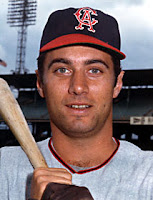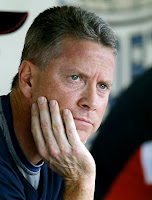Of the 11, only Seaver is wearing a Mets cap on his Hall of Fame plaque. And only Carter (600 games), Seaver (420 games) and Murray (310 games) played in at least 250 games as a Met.
Most of this information you already know, especially if you've read Greg Prince's excellent discussions on the topic in his blog, Faith and Fear In Flushing. In all likelihood, you also know that Seaver is the only player who has had his number retired by the Mets (Casey Stengel's No. 37 and Gil Hodges' No. 14 were retired because of what they did as managers). But what about former Mets players who have had their uniform numbers retired by other teams?
The ten Mets Hall of Famers not named Seaver have all had their numbers retired by other teams, with one player (Nolan Ryan) receiving the honor from three teams. But there are six other former Mets who have not been voted into the Hall of Fame (although one is not yet eligible), yet have had their uniform numbers retired by another team. Let's take a look at those six players, some of which might cause you to look away once you see their names.
Ken Boyer
One of many former Mets who tried (and failed) to make the third base position his own in the 1960s, Ken Boyer spent the majority of his career as a Gold Glove-winning All-Star in St. Louis. Defensively, Boyer won five Gold Gloves manning the hot corner in St. Louis. Offensively, Boyer drove in over 1,000 runs in 11 years as a Cardinal and was named the 1964 National League MVP. In St. Louis, Boyer enjoyed seven 20-HR seasons and hit over .300 five times. In 1½ seasons with the Mets (1966-67), Boyer batted .258 and managed 17 homers. Boyer's No. 14 was retired by the Cardinals in 1984.
Jim Fregosi
Even Mets fans who hadn't been born by December 10, 1971 know why that date is notorious. On that date, the team made what is still considered to be the worst trade in team history when they sent Nolan Ryan to the California Angels for shortstop Jim Fregosi, who would be asked to play third base for the Mets. Ryan went on the have his number retired by the other three teams he played for (more on that later), while Mets fans wish Fregosi had retired before the day of the trade. The Angels retired Fregosi's No. 11 in 1998, just five years after Ryan retired from pitching.
Glavine won his 300th game as a Met, but no one really cares. It's the one game he didn't win (and his post-game reaction to it) that everyone will remember him for. The southpaw's Met career ended the way it began, with a horrible performance that resulted in him exiting the game to a chorus of boos from the Shea Faithful. Glavine won 244 games as an Atlanta Brave and had his No. 47 retired by the team in 2010. I'm sure he wasn't devastated on the day it was retired.
 Randy Jones
Randy JonesAlthough Jones went 92-105 as a San Diego Padre, his No. 35 was retired by the Friars in 1997. Jones had two 20-win seasons in San Diego, which came immediately after he recorded a 20-loss season in 1974. Take out Jones' two 20-win campaigns and his best single-season record came in his rookie year (1973) when he finished a mediocre 7-6. Jones spent his final two seasons in the big leagues as a Met, leaving his afro and ability to pitch on the West Coast.
Mike Scott
In four years as a Met, Mike Scott went 14-27 and never struck out 100 batters in a single season. Then he became an Astro, had a little chat with original Met Roger Craig, got Santa Claus to bring him a "Scuffing For Dummies" book and became a Cy Young Award winner. He almost single-handedly eliminated the Mets in the 1986 NLCS. Six years later, Scott's No. 33 (and nail file) was raised to the Astrodome roof.
Rusty Staub
Staub played for the Mets before and after he played for the team that eventually retired his number. Le Grand Orange was traded by Montreal to the Mets in 1972 after making the All-Star team in each of his three seasons as an Expo. In 1979, Staub returned to Montreal, two years before coming back to the Mets. Staub was no longer in the proper shape to be an everyday player (although his body certainly had a proper shape), but was still able to contribute to the team, becoming one of the most productive pinch-hitters in franchise history. Staub's No. 10 was retired by the Expos in 1993. His two numbers with the Mets (No. 4, No. 10) are still in circulation.






No comments:
Post a Comment